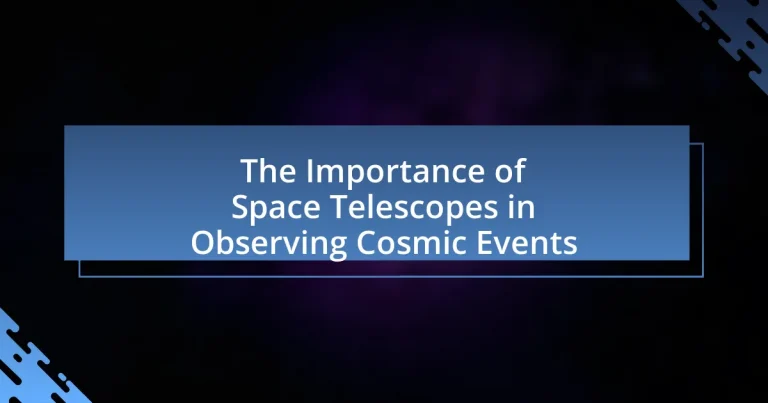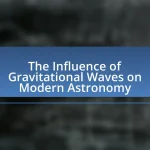Space telescopes are astronomical instruments positioned outside Earth’s atmosphere, enabling clearer observations of celestial objects and phenomena without atmospheric interference. This article explores the significance of space telescopes in observing cosmic events, highlighting their advantages over ground-based telescopes, such as the ability to capture a broader spectrum of electromagnetic radiation. Key missions of notable space telescopes, including the Hubble Space Telescope and the James Webb Space Telescope, are discussed, along with their contributions to understanding cosmic events, black holes, exoplanets, and the universe’s evolution. The article also addresses future prospects for space telescopes and the importance of public engagement and support for these initiatives.
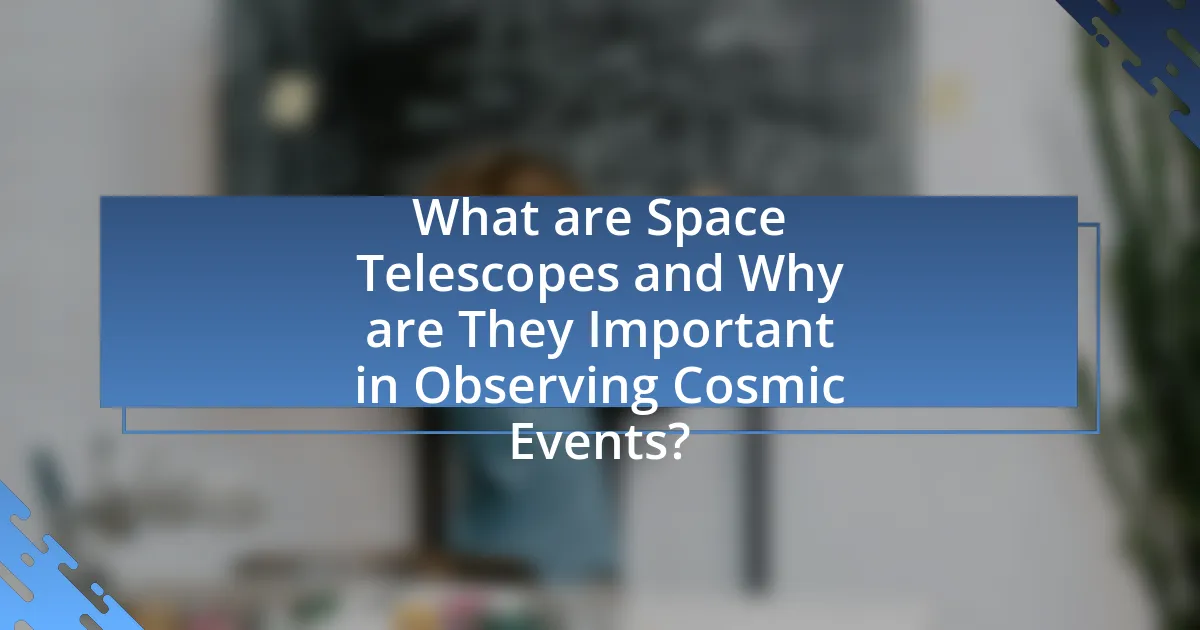
What are Space Telescopes and Why are They Important in Observing Cosmic Events?
Space telescopes are astronomical instruments located outside Earth’s atmosphere that observe celestial objects and phenomena. They are important in observing cosmic events because they can capture clearer images and data without atmospheric interference, which distorts light and limits the capabilities of ground-based telescopes. For instance, the Hubble Space Telescope has provided invaluable insights into the formation of galaxies, the expansion of the universe, and the presence of exoplanets, demonstrating the enhanced observational power that space telescopes offer. Their ability to operate across various wavelengths, including ultraviolet and infrared, allows scientists to study cosmic events in greater detail, leading to significant advancements in our understanding of the universe.
How do Space Telescopes differ from Ground-Based Telescopes?
Space telescopes differ from ground-based telescopes primarily in their location, which allows them to avoid atmospheric interference. Space telescopes operate above Earth’s atmosphere, enabling them to capture clearer images and a broader spectrum of electromagnetic radiation, including ultraviolet and infrared light, which are absorbed by the atmosphere. For instance, the Hubble Space Telescope, launched in 1990, has provided unprecedented views of distant galaxies and nebulae due to its position in low Earth orbit, free from atmospheric distortion. In contrast, ground-based telescopes, such as the Keck Observatory in Hawaii, face challenges like light pollution and atmospheric turbulence, which can significantly degrade image quality. This fundamental difference in operational environment is crucial for the effectiveness of space telescopes in observing cosmic events.
What advantages do Space Telescopes have over Ground-Based Telescopes?
Space telescopes have significant advantages over ground-based telescopes, primarily due to their location beyond Earth’s atmosphere. This positioning allows space telescopes to avoid atmospheric distortion, which can blur images and limit the clarity of observations. For instance, the Hubble Space Telescope, operating in low Earth orbit, has provided exceptionally clear images of distant galaxies and nebulae, free from atmospheric interference. Additionally, space telescopes can observe a broader range of wavelengths, including ultraviolet and infrared, which are absorbed by the atmosphere, enabling them to gather data that ground-based telescopes cannot. This capability enhances our understanding of cosmic events and the universe’s structure.
How do atmospheric conditions affect observations from Ground-Based Telescopes?
Atmospheric conditions significantly impact observations from ground-based telescopes by introducing distortions and limiting visibility. Factors such as turbulence, humidity, and light pollution can cause blurring of images, reduce contrast, and obscure celestial objects. For instance, atmospheric turbulence leads to a phenomenon known as “seeing,” which can vary from one night to another, affecting the clarity of the observed images. Additionally, water vapor in the atmosphere can absorb certain wavelengths of light, diminishing the ability to observe specific astronomical phenomena. Studies have shown that ground-based observations can be hindered by up to 50% due to these atmospheric effects, underscoring the limitations compared to space telescopes, which operate above the atmosphere and avoid these issues entirely.
What types of Cosmic Events can Space Telescopes observe?
Space telescopes can observe a variety of cosmic events, including supernovae, gamma-ray bursts, black hole mergers, and the formation of galaxies. These telescopes, such as the Hubble Space Telescope and the James Webb Space Telescope, utilize advanced imaging and spectroscopy techniques to capture light from these events across different wavelengths. For instance, supernovae can be detected in optical and infrared light, while gamma-ray bursts are observed in high-energy gamma rays, providing insights into the life cycles of stars and the expansion of the universe. The ability to observe these phenomena has led to significant discoveries, such as the acceleration of the universe’s expansion, confirmed by observations of distant supernovae.
How do Space Telescopes detect supernovae and gamma-ray bursts?
Space telescopes detect supernovae and gamma-ray bursts by utilizing advanced imaging and spectroscopy techniques to observe the light and radiation emitted during these explosive cosmic events. For instance, telescopes like the Hubble Space Telescope and the Chandra X-ray Observatory capture the visible and X-ray emissions from supernovae, while the Fermi Gamma-ray Space Telescope specializes in detecting high-energy gamma rays associated with gamma-ray bursts. These observations allow astronomers to analyze the characteristics of the explosions, such as their brightness and spectrum, providing insights into the underlying physics and the distance of these events. The ability to monitor these phenomena in real-time enhances our understanding of the universe and the life cycles of stars.
What role do Space Telescopes play in studying black holes and neutron stars?
Space telescopes play a crucial role in studying black holes and neutron stars by providing high-resolution observations across various wavelengths, including X-rays and gamma rays. These observations allow scientists to detect the intense radiation emitted by matter as it accelerates and heats up near these extreme objects, enabling the identification of their presence and properties. For instance, the Chandra X-ray Observatory has captured images of X-ray emissions from the vicinity of black holes, revealing their mass and spin, while the Fermi Gamma-ray Space Telescope has detected gamma-ray bursts associated with neutron star collisions. Such data is essential for understanding the fundamental physics of these cosmic phenomena and their impact on the universe.
Why is the data collected by Space Telescopes crucial for astronomical research?
The data collected by space telescopes is crucial for astronomical research because it provides high-resolution images and spectra of celestial objects without the interference of Earth’s atmosphere. This capability allows astronomers to observe distant galaxies, stars, and exoplanets in unprecedented detail, leading to significant discoveries such as the identification of exoplanets and the measurement of cosmic distances. For instance, the Hubble Space Telescope has contributed to the understanding of the expansion rate of the universe by providing accurate measurements of distant supernovae, which has been pivotal in the discovery of dark energy.
How does the data from Space Telescopes contribute to our understanding of the universe’s evolution?
Data from space telescopes significantly enhances our understanding of the universe’s evolution by providing detailed observations of celestial phenomena across various wavelengths. For instance, the Hubble Space Telescope has captured images of distant galaxies, allowing astronomers to study their formation and development over billions of years. This data reveals the rate of star formation and the influence of dark matter, which are crucial for understanding cosmic evolution. Additionally, the James Webb Space Telescope offers insights into the early universe by observing the first galaxies formed after the Big Bang, thus contributing to models of cosmic expansion and structure formation. These observations are backed by extensive research, including studies published in journals like “The Astrophysical Journal,” which detail the findings from these telescopes and their implications for cosmology.
What insights have Space Telescopes provided about exoplanets and their atmospheres?
Space telescopes have provided critical insights into exoplanets and their atmospheres by enabling the detection of atmospheric compositions and conditions through techniques such as transit spectroscopy. For instance, the Hubble Space Telescope has identified the presence of water vapor in the atmospheres of exoplanets like WASP-121b, revealing details about their chemical makeup. Additionally, the James Webb Space Telescope has enhanced this capability, allowing for the analysis of more complex molecules, such as carbon dioxide and methane, in exoplanetary atmospheres. These observations contribute to our understanding of potential habitability and the diverse range of atmospheric phenomena present in different exoplanetary systems.
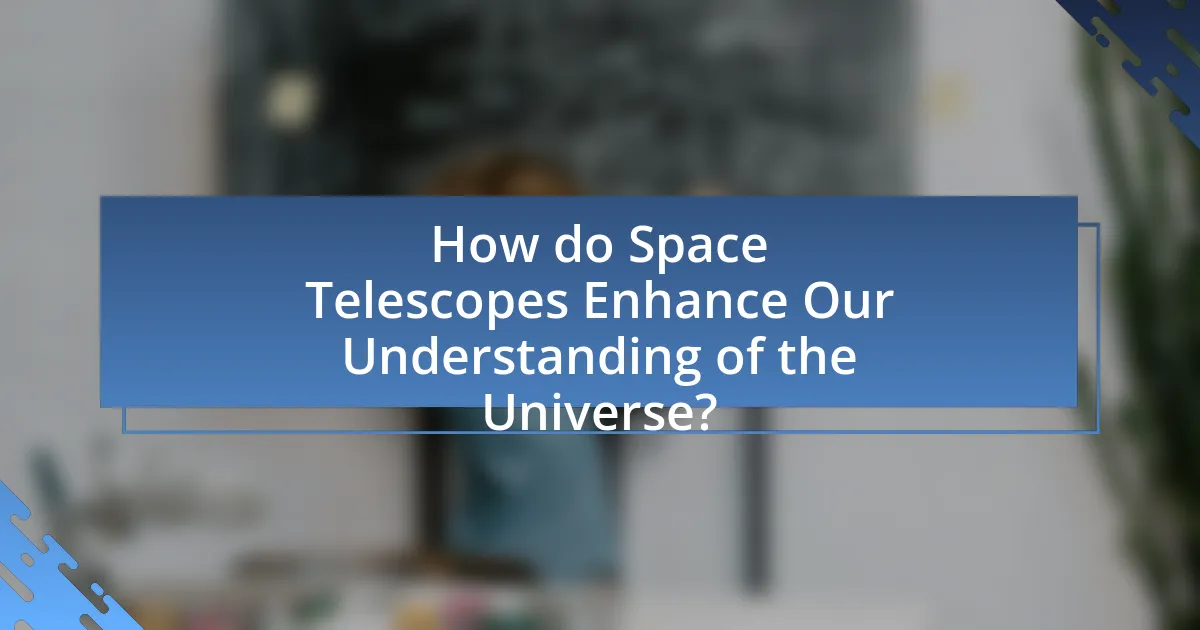
How do Space Telescopes Enhance Our Understanding of the Universe?
Space telescopes enhance our understanding of the universe by providing unobstructed views of celestial objects, free from Earth’s atmospheric interference. This capability allows for clearer and more detailed observations across various wavelengths, including infrared, ultraviolet, and X-rays. For instance, the Hubble Space Telescope has captured images of distant galaxies, revealing their formation and evolution over billions of years, while the Chandra X-ray Observatory has provided insights into high-energy phenomena such as black holes and supernovae. These observations lead to significant discoveries, such as the acceleration of the universe’s expansion, supported by data from the Hubble Space Telescope, which has measured the rate of expansion with high precision. Thus, space telescopes are crucial for advancing our knowledge of cosmic events and the fundamental laws governing the universe.
What are the key missions of notable Space Telescopes?
Notable space telescopes have key missions that include observing distant galaxies, studying the cosmic microwave background, and analyzing exoplanets. For instance, the Hubble Space Telescope has provided critical insights into the expansion of the universe and the formation of stars and galaxies since its launch in 1990. The Kepler Space Telescope, operational from 2009 to 2018, focused on discovering Earth-sized exoplanets in habitable zones around stars, identifying over 2,600 confirmed planets. The James Webb Space Telescope, launched in December 2021, aims to observe the formation of stars and galaxies in the early universe, utilizing infrared technology to penetrate cosmic dust. Each of these missions contributes significantly to our understanding of the universe and its evolution.
How has the Hubble Space Telescope changed our view of the cosmos?
The Hubble Space Telescope has fundamentally transformed our understanding of the cosmos by providing unprecedented clarity and detail in astronomical observations. Launched in 1990, Hubble has captured high-resolution images of distant galaxies, nebulae, and other celestial phenomena, revealing the universe’s structure and evolution. For instance, Hubble’s observations have led to the discovery of the accelerating expansion of the universe, which was evidenced by its measurements of distant supernovae, contributing to the understanding of dark energy. Additionally, Hubble has provided insights into the formation of stars and planetary systems, as well as the presence of exoplanets, enhancing our knowledge of potential life beyond Earth.
What discoveries have been made by the James Webb Space Telescope?
The James Webb Space Telescope has made significant discoveries, including the detection of the most distant galaxy ever observed, named GLASS-z13, which formed just 300 million years after the Big Bang. This discovery provides insights into the early universe and galaxy formation. Additionally, the telescope has identified water vapor in the atmosphere of exoplanets, such as WASP-39 b, enhancing our understanding of planetary atmospheres and potential habitability. Furthermore, it has captured detailed images of star formation in the Carina Nebula, revealing previously hidden structures and processes. These findings underscore the telescope’s role in advancing our knowledge of cosmic events and the evolution of the universe.
How do Space Telescopes contribute to international collaboration in astronomy?
Space telescopes significantly enhance international collaboration in astronomy by enabling shared access to high-quality data and fostering joint research initiatives. For instance, the Hubble Space Telescope has been utilized by thousands of scientists from various countries, leading to over 15,000 scientific papers published collaboratively. Additionally, missions like the James Webb Space Telescope involve partnerships between space agencies such as NASA, ESA, and CSA, promoting resource sharing and collective expertise. This collaborative framework not only accelerates discoveries but also cultivates a global scientific community dedicated to understanding the universe.
What partnerships exist between different countries for Space Telescope missions?
NASA and the European Space Agency (ESA) have partnered on several space telescope missions, most notably the Hubble Space Telescope, which launched in 1990. This collaboration involved shared funding, scientific expertise, and operational responsibilities, allowing both agencies to maximize the telescope’s capabilities and scientific output. Additionally, the James Webb Space Telescope, launched in December 2021, is a joint project between NASA, ESA, and the Canadian Space Agency (CSA), further exemplifying international cooperation in space exploration. These partnerships enhance the scientific community’s ability to observe and understand cosmic events through shared resources and knowledge.
How does data sharing enhance global astronomical research?
Data sharing enhances global astronomical research by facilitating collaboration among scientists worldwide, allowing them to access and analyze vast datasets from various space telescopes. This collaborative approach accelerates discoveries, as researchers can combine their expertise and resources to interpret complex astronomical phenomena. For instance, the Hubble Space Telescope’s data has been shared openly, leading to significant findings such as the measurement of the universe’s expansion rate, which was published in the Astrophysical Journal in 2019 by Riess et al. This openness not only fosters innovation but also ensures that findings are reproducible and verifiable, strengthening the overall scientific process.
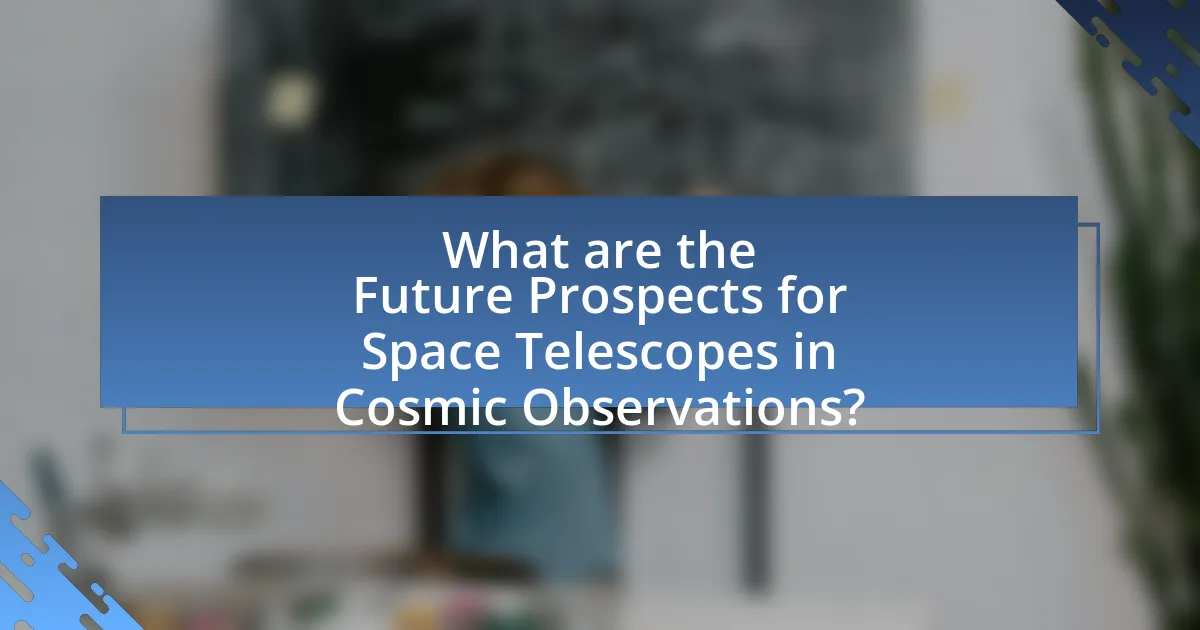
What are the Future Prospects for Space Telescopes in Cosmic Observations?
The future prospects for space telescopes in cosmic observations are highly promising, with advancements in technology enabling deeper and more detailed exploration of the universe. Upcoming missions, such as the James Webb Space Telescope, are designed to observe the universe in unprecedented detail, allowing scientists to study the formation of stars, galaxies, and potentially habitable exoplanets. Additionally, planned telescopes like the Roman Space Telescope aim to investigate dark energy and dark matter, further enhancing our understanding of cosmic phenomena. These developments are supported by historical successes of previous space telescopes, such as Hubble, which has provided critical insights into the age and expansion of the universe, demonstrating the significant impact of space-based observations on astrophysics.
What upcoming Space Telescope missions are on the horizon?
The upcoming space telescope missions on the horizon include the James Webb Space Telescope (JWST) continuing its operations, the Roman Space Telescope set to launch in 2027, and the European Space Agency’s Euclid mission scheduled for launch in 2023. JWST, launched in December 2021, is already providing unprecedented views of the universe. The Roman Space Telescope will focus on dark energy and exoplanets, while Euclid aims to map the geometry of the dark universe. These missions are crucial for advancing our understanding of cosmic events and the structure of the universe.
How will the next generation of Space Telescopes improve our observational capabilities?
The next generation of space telescopes will significantly enhance our observational capabilities by utilizing advanced technologies such as larger mirrors, improved detectors, and enhanced spectroscopic instruments. These advancements will allow for greater light collection, enabling the observation of fainter and more distant celestial objects, which is crucial for studying the early universe and the formation of galaxies. For instance, the James Webb Space Telescope, set to launch in December 2021, features a 6.5-meter mirror that is over two and a half times larger than that of its predecessor, the Hubble Space Telescope, allowing it to capture images with unprecedented clarity and detail. Additionally, these telescopes will operate in a wider range of wavelengths, including infrared, which is essential for penetrating cosmic dust and observing phenomena such as star formation and exoplanet atmospheres.
What technologies are being developed for future Space Telescopes?
Future space telescopes are being developed with advanced technologies such as segmented mirrors, adaptive optics, and infrared detectors. Segmented mirrors, like those planned for the James Webb Space Telescope, allow for larger apertures that enhance light-gathering capabilities. Adaptive optics technology is being refined to correct for atmospheric distortions, improving image clarity. Additionally, next-generation infrared detectors are being designed to capture faint cosmic signals, enabling the observation of distant galaxies and exoplanets. These technologies are crucial for expanding our understanding of the universe and observing cosmic events with unprecedented detail.
How can the public engage with and support Space Telescope initiatives?
The public can engage with and support Space Telescope initiatives by participating in outreach programs, contributing to crowdfunding campaigns, and advocating for space science funding. Outreach programs, such as public lectures and educational workshops, allow individuals to learn about the science behind space telescopes and their discoveries. Crowdfunding campaigns, like those launched for specific telescope projects, enable the public to financially support initiatives directly. Additionally, advocating for increased funding for space science through petitions or contacting representatives can help ensure continued investment in space telescope research, which has led to significant discoveries, such as the detection of exoplanets and insights into the early universe.
What educational resources are available for learning about Space Telescopes?
Educational resources for learning about space telescopes include online courses, textbooks, documentaries, and websites dedicated to astronomy. Online platforms like Coursera and edX offer courses on astrophysics and space science that cover the principles of space telescopes. Textbooks such as “The Hubble Space Telescope: From Concept to Success” provide in-depth knowledge about specific missions and technologies. Documentaries like “The Universe” series explore the impact of space telescopes on our understanding of the cosmos. Additionally, websites like NASA’s official site and the European Space Agency provide extensive educational materials, including articles, videos, and interactive tools related to space telescopes and their discoveries.
How can individuals contribute to Space Telescope funding and advocacy?
Individuals can contribute to Space Telescope funding and advocacy by making direct financial donations to organizations like NASA or the Space Telescope Science Institute, which manage funding for space telescopes. Additionally, individuals can participate in advocacy efforts by joining or supporting non-profit organizations that promote space exploration and education, such as the Planetary Society, which actively campaigns for funding and public awareness of space science initiatives. Engaging in social media campaigns, writing to legislators, and participating in public outreach events also amplify individual voices in support of space telescope projects, thereby influencing funding decisions and public interest.
